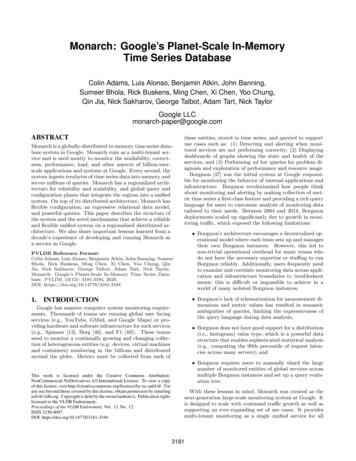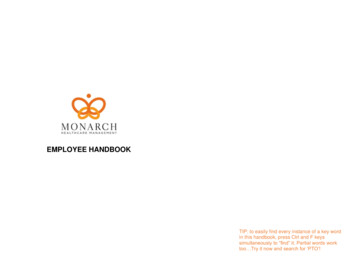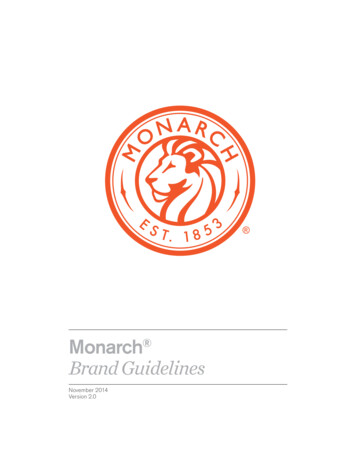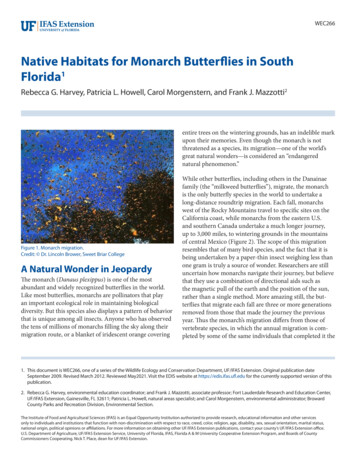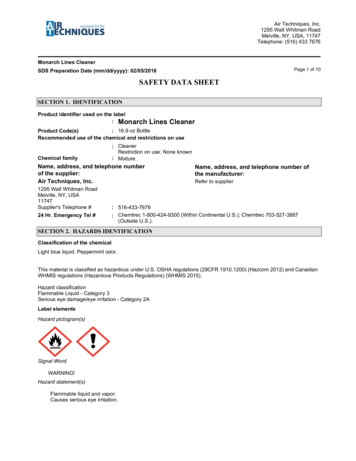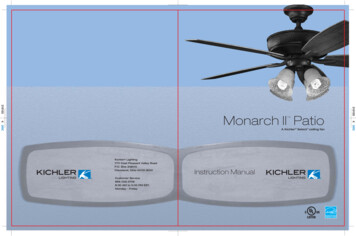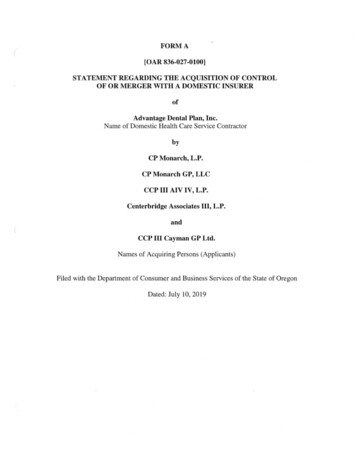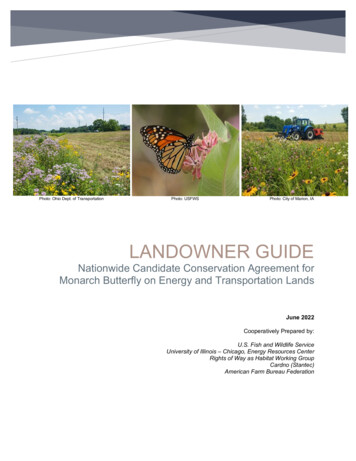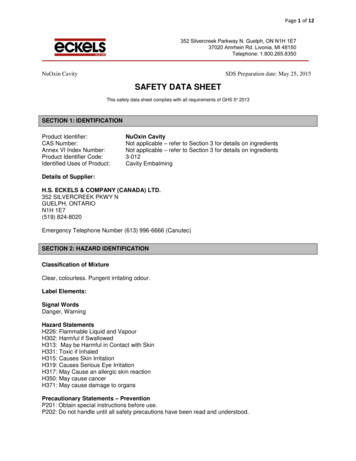
Transcription
Page 1 of 12NuOxin CavitySDS Preparation date: May 25, 2015SAFETY DATA SHEETThis safety data sheet complies with all requirements of GHS 5e 2013SECTION 1: IDENTIFICATIONProduct Identifier:CAS Number:Annex VI Index Number:Product Identifier Code:Identified Uses of Product:NuOxin CavityNot applicable – refer to Section 3 for details on ingredientsNot applicable – refer to Section 3 for details on ingredients3-012Cavity EmbalmingDetails of Supplier:H.S. ECKELS & COMPANY (CANADA) LTD.352 SILVERCREEK PKWY NGUELPH, ONTARION1H 1E7(519) 824-8020Emergency Telephone Number (613) 996-6666 (Canutec)SECTION 2: HAZARD IDENTIFICATIONClassification of MixtureClear, colourless. Pungent irritating odour.Label Elements:Signal WordsDanger, WarningHazard StatementsH226: Flammable Liquid and VapourH302: Harmful if SwallowedH313: May be Harmful in Contact with SkinH331: Toxic if InhaledH315: Causes Skin IrritationH319: Causes Serious Eye IrritationH317: May Cause an allergic skin reactionH350: May cause cancerH371: May cause damage to organsPrecautionary Statements – PreventionP201: Obtain special instructions before use.P202: Do not handle until all safety precautions have been read and understood.
Page 2 of 12NuOxin CavitySDS Preparation date: May 25, 2015SAFETY DATA SHEETThis safety data sheet complies with all requirements of GHS 5e 2013P210: Keep away from heat, sparks, open flames and hot surfaces. - No smoking.P233: Keep container tightly closed.P243: Take precautionary measures against static discharge.P260: Do not breathe fumes, mists, vapours or spray.P264: Wash contacted areas thoroughly after handling.P270: Do not eat, drink or smoke when using this product.P271: Use only outdoors or in a well ventilated area.P272: Contaminated work clothing should not be allowed out of the workplace.P273: Avoid release to the environmentP280: Wear protective gloves, protective clothing and eye or face protection.Precautionary Statements - ResponseP301 P311 P330: IF SWALLOWED: call a POISON CENTRE or doctor. Induce vomiting, rinse mouthand seek medical attention.P302 P352 P362: IF ON SKIN: Take off all contaminated clothing. Wash with plenty of water for at least20 minutes.P304 P340: IF INHALED: Remove victim to fresh air and keep at rest in a position comfortable forbreathing.P305 P351 P338: IF IN EYES: Rinse cautiously with water for at least 20 minutes. Remove contactlenses, if present and easy to do. Continue rinsing.P308 P313: If exposed or concerned: Get medical advice.P332 P313: If skin irritation occurs: Seek immediate medical attention.P333 P313: If skin irritation or rash occurs: Seek immediate medical attention.P337 P313: If eye irritation persists: Seek immediate medical attention.P370 P378: In case of fire, use carbon dioxide, alcohol foam, dry chemical or water spray.Precautionary Statements - StorageP405: Store locked up.P403 P233: Store in a well-ventilated place. Keep container tightly closed.Precautionary Statements - DisposalP501: Review federal, provincial or state, and local government requirements prior to disposal. For largequantities, if recycling or reclaiming is not possible, use a commercial waste disposal service.Hazard SymbolsFlameSkull and Cross BonesExclamation MarkHealth Hazard
Page 3 of 12NuOxin CavitySDS Preparation date: May 25, 2015SAFETY DATA SHEETThis safety data sheet complies with all requirements of GHS 5e 2013SECTION 3: COMPOSITION/INFORMATION ON INGREDIENTSTable 3.1: Ingredients of MixtureChemical NameCAS NumberEC NumberConcentration 00-659-639-50SECTION 4: FIRST-AID MEASURESNecessary First-Aid Measures upon:InhalationEye ContactSkin ContactIngestionRemove source of contamination or move victim to fresh air. If breathing hasstopped give artificial respiration, obtain medical attention immediately.Flush eyes with lukewarm warm water for at least 20 minutes, holding the eyelids open. If irritation persists, obtain medical attention immediately.Avoid direct contact, remove contaminated clothing flush immediately withlukewarm water for at least 20 minutes. If irritation persists, obtain medicalattention immediately.Induce vomiting immediately, obtain medical attention immediately.Most Important EffectsToxic if swallowed.Vapours can cause permanent eye damage.Prolonged exposure to skin can cause dermatitis.Repeated exposure to skin can cause sensitizationInhalation of large amounts is toxic.Most Important SymptomsImmediateIrritation of effected areaNausea and abdominal painInflammation of eyelidsDelayedCollapse and UnconsciousnessBroncho-pneumonia
Page 4 of 12NuOxin CavitySDS Preparation date: May 25, 2015SAFETY DATA SHEETThis safety data sheet complies with all requirements of GHS 5e 2013Additional InformationClinical TestingClinical tests to determine toxicity have been performed on rat and rabbit. Seetable 11.1 for details. Clinical testing has been performed to determinecarcinogenicity. See Section 1 for details.Medical MonitoringTreat symptomatically. Immediate medical attention is required.AntidotesNo antidotes have been listed for this mixture.ContraindicationsNo contraindications have been listed for this mixture.SECTION 5: FIRE-FIGHTING MEASURESSuitable Extinguishing MediaCarbon dioxide, alcohol foam, dry chemical, water spray.Specific Hazards arising for Combustion of the ProductMay form formaldehyde gas, carbon oxides, hydrogen, formic acid and variousHydrocarbons.Special Protective Actions for Fire-FightersWear self-contained breathing apparatus and complete personal protective equipment.SECTION 6: ACCIDENTAL RELEASE MEASURESPersonal PrecautionsProtective EquipmentAvoid breathing vapour. Ventilate area. Eliminate ignition sources.Respiratory protection:Protective Gloves:Use NIOSH approved respiratory equipment.PVC, nitrile or neoprene rubber should be worn to prevent prolonged orrepeated skin contact.Eye Protection:Chemical safety goggles should be worn to prevent eye contact.Other Protective equipment: Eye wash fountain and safety shower must be available in areas where thismaterial is used.Emergency ProceduresVentilate area using local exhaust ventilation to control airborne vapours.Eliminate ignition sources.Environmental CautionsThis product is listed as harmful to aquatic life. Please refer to Section12 for complete ecological effects.If large amounts are spilled please notify your local environmental agency.Methods and Materials for:
Page 5 of 12NuOxin CavitySDS Preparation date: May 25, 2015SAFETY DATA SHEETThis safety data sheet complies with all requirements of GHS 5e 2013ContainmentNeutralize with diluted solutions of ammonia. Contain spill with inertabsorbent material.Review federal, provincial or state, and local government requirementsprior to disposal. For large quantities, if recycling or reclaiming is notpossible, use a commercial waste disposal service. Please refer toSection 13 for complete disposal procedures.Clean UpSECTION 7: HANDLING AND STORAGEPrecautions for Safe HandlingSpecificAvoid contact with eyes, skin and clothing. Avoid breathing vapours.Wash thoroughly with soap and water after handling. Please refer toSection 6 for details on appropriate PPE.General Hygiene ConsiderationsEating, drinking, smoking and applying cosmetics in work areas isprohibited.Remove all contaminated clothing and PPE before entering eating areas.Precautions for Safe StorageStore in a cool, dry, ventilated area. Keep away from heat, sparks andflames. Do not store below 35 F (1 C) or above 105 F (40 C).SECTION 8: EXPOSURE CONTROLS/PERSONAL PROTECTIONControl ParametersTable 8.1: Exposure LimitsChemical NameTLV-C (ACGIH)TLV-TWA(ACGIH)TLV-TWA(OSHA)TLV-STEL (OSHA)Formaldehyde0.3ppm0.75ppmNot Available2.0ppmMethanol250ppmNot Available200ppmNot AvailableExposure ControlsKeep container tightly closed. Do not handle until all safety precautions have been readand understood. Ensure all personnel wear appropriate PPE at all times when handlingthis product. Contaminated work clothing should not be allowed out of the workplace.
Page 6 of 12NuOxin CavitySDS Preparation date: May 25, 2015SAFETY DATA SHEETThis safety data sheet complies with all requirements of GHS 5e 2013Engineered Protection MeasuresUse local exhaust ventilators to control airborne vapours.Individual Protection MeasuresGeneral hygiene measures and appropriate PPE should be used in conjunction with theafore mentioned engineered measures of protection. Also see Section 5 for additionalprotection measures in case of fire.Eye/Face ProtectionSkin ProtectionRespiratory ProtectionThermal HazardsChemical safety goggles should be worn to prevent eye contact.PVC, nitrile or neoprene rubber gloves should be worn to preventprolonged or repeated skin contact.NIOSH approved respiratory equipment should be worn to preventinhalation of vapours.This mixture does not present a thermal hazard under normal use.SECTION 9: PHYSICAL AND CHEMICAL PROPERTIESInformation on Physical and Chemical Properties of MixtureAppearanceOdourOdour ThresholdpHMelting/Freezing PointBoiling Point and RangeFlash PointEvaporation Rate(BuAe 1)Flammability (Solid, Gas)Upper Explosive LimitLower Explosive LimitVapour PressureVapour Density (air 1)Relative DensitySolubilityPartition Coefficient: n-octanol/waterAuto-Ignition TempDecomposition TempViscosityClear, colourlessPungent irritating odour0.05-0.5 (Formaldehyde)7.0-7.5Not Available64.4 C38.8 C 1Yes as Solid73%6%43mmHg (at 22 C) 1Not Available100%Not AvailableNot AvailableNot AvailableNot AvailableSECTION 10: STABILITY AND REACTIVITY
Page 7 of 12NuOxin CavitySDS Preparation date: May 25, 2015SAFETY DATA SHEETThis safety data sheet complies with all requirements of GHS 5e 2013ReactivityChemical StabilityPossibility of Hazardous ReactionsConditions to AvoidIncompatibility MaterialsHazardous Decomposition ProductsNot normally reactiveStableHazardous polymerization does not occur.There are no specific conditions to avoid during normal useof this product.Strong alkali and oxidizing agents. Hydrochloric acid.Carbon dioxide, carbon monoxide, hydrogen andformaldehyde gas. Reaction with hydrochloric acid mayform bis-chloromethyl ether which is a suspected humancarcinogen according to ACGIH and carcinogenic to humansaccording to IARCSECTION 11 : TOXICOLOGICAL INFORMATIONToxicological Data of IngredientsAcute ToxicityThis substance is classified as a Toxic Material – Toxic ifInhaled, according to GHS Regulation, Hazard Category 3.This substance is classified as a Harmful Material – Harmful ifSwallowed according to GHS Regulation, Hazard Category 4.This substance is classified as a Possible Harmful Material –May be Harmful in contact with Skin according to GHSRegulation, Hazard Category 5.Skin Corrosion/IrritationThis substance is classified as a Skin Irritant – Causes SkinIrritation according to GHS Regulation, Hazard Category 2.Serious Eye Damage/IrritationThis substance is classified as a Serious Eye Irritant – CausesSerious Eye Irritation according to GHS Regulation, HazardCategory 2A.Respiratory or Skin SensitizationThis substance is classified as a Skin Sensitizer – May Cause anAllergic Skin Reaction according to GHS Regulation, HazardCategory 1.Germ Cell MutagenicityNot classified as a germ cell mutagenic hazard.CarcinogenicityThis substance is categorized as a Known or presumed humancarcinogen – May Cause Cancer according to GHS Regulations,
Page 8 of 12NuOxin CavitySDS Preparation date: May 25, 2015SAFETY DATA SHEETThis safety data sheet complies with all requirements of GHS 5e 2013Hazard Category 1A. Formaldehyde is listed by IARC ascarcinogenic to humans, on the basis of human evidence (group1A).Reproductive ToxicityNot classified as a reproductive hazard.STOT – Single ExposureThis substance is classified as a possible hazard for target organtoxicity in a single exposure – May Cause Damage to Organsaccording to GHS Regulations, Hazard category 2.STOT – Repeated ExposureNot classified as a hazard for target organ toxicity in repeatedexposure.Aspiration HazardNot classified as an aspiration hazard.Routes of ExposureInhalation, Eye Contact, Skin Contact, IngestionEffects of Acute Exposure via:InhalationEye ContactSkin ContactIngestionChronic effectsIrritation of upper respiratory tract, inflammation of eyelids, visualimpairment, bronchitis, broncho-pneumonia, death. Methanolvapours can cause dizziness, fatigue, nausea and intestinaldisturbance.Vapours can cause eye irritation; liquid can cause severe eyeburns including permanent eye damage.Hardening or tanning of skin, irritation of skin, cracking of skin,dermatitis. Prolonged or repeated skin contact can result in skinsensitizationSevere abdominal pain, collapse, unconsciousness, temporaryvisual impairment, permanent visual impairment, deathFormaldehyde may cause carcinogenic effects. See aboveinformation for details.Table 11.1: Toxicity Data for Hazardous IngredientsChemical NameLC50 (Rat.Ihl)LD50 (Rat.oral)LD50 ol64,000ppm/4hr13000mg/kg20,000mg/kgInteractive EffectsNo interactive effects are listed for this mixture.SECTION 12: ECOLOGICAL INFORMATION
Page 9 of 12NuOxin CavitySDS Preparation date: May 25, 2015SAFETY DATA SHEETThis safety data sheet complies with all requirements of GHS 5e 2013Ecotoxicological PropertiesAcute Aquatic ToxicityChronic Aquatic ToxicityPersistence and DegradabilityBioaccumulative PotentialMobility in SoilOther Adverse EffectsThis product is classified as harmful to aquatic life: harmful toinvertebrates according to GHS regulations.This product is classified as not toxic to aquatic life according to GHSregulations.This product is considered to be readily biodegradable.This product is not considered to be bioaccumulative.This product is considered to have low soil mobility.Methanol levels over 0.1% may be toxic to sewage bacteria.SECTION 13: DISPOSAL CONSIDERSATIONSPlease refer to Sections 7 and 8 for proper storage, handling and personal protective measures.Disposal Containers and MethodsProduct DisposalAvoid disposal of this product via sewage systems.Review federal, provincial or state, and local government requirementsprior to disposal.Disposal by controlled incineration or by secure land fill may beacceptable.Container DisposalEmpty containers may contain hazardous residue. Return to supplier forreuse if possible. Never weld, cut or grind empty containers. If disposingof containers, ensure they are well rinsed with water, then disposed of atan authorised landfill. After cleaning, all existing labels should beremoved.Properties affecting Disposal OptionsMethanol levels over 0.1% may be toxic to sewage bacteria.Special Precautions for Incinerators or LandfillsNo special precautions for incinerators or landfills are listed for this product. See Section 12 for completeecological information.SECTION 14: TRANSPORT INFORMATIONRegulationUN NumberDescriptionClassGroupSymbols
Page 10 of 12NuOxin CavitySDS Preparation date: May 25, 2015SAFETY DATA SHEETThis safety data sheet complies with all requirements of GHS 5e 2013TDG1UN1993Flammable Liquid n.o.s3IIIDOT1,2UN1993Flammable Liquid n.o.s.(contains Formaldehyde,Methanol)3IIIG1This material may be shipped as Limited Quantity when in containers with a volume no larger than 5.0Land in packages not exceeding 30 kg gross mass.2See 49 CFR Section 173.27 and 175.75 for complete disclosure of quantity limitations.SECTION 15: REGULATORY INFORMATIONCanadian Environmental Protection Act (CEPA) information: All ingredients listed appear on the DomesticSubstances List (DSL).This product has been classified in accordance with the hazard criteria of the CPR and the SDS containsall of the information required by the CPR.US Federal Information:TSCA: All listed ingredients appear on the TSCA inventory.CERCLA Reportable Quantity (RQ) (40 CFR 117.302): formaldehyde (100 lbs / 45.4 kg); Methanol (5000lbs / 2270 kg).ECPRA (SARA TITLE III):Section 302, Extremely Hazardous Substances, 40 CFR 355: This product contains an ExtremelyHazardous Substance under SARA Section 302. Contains: formaldehyde.Sections 311 and 312, 40 CFR 370 Hazard Classes: Fire Hazard; Health Hazard; Chronic Health Hazard.See section 302 SARA Title III and 40 CFR 355 Appendix A & B for additional information regardingthreshold quantities for the reporting of hazardous chemicals.Section 313, Toxic Chemicals Notification, 40 CFR 372: This product may be subject to SARA notificationrequirements, since it contains Toxic Chemical constituents above their de minimus concentrations. Thisproduct contains: formaldehyde; Methanol.US State Right to Know Laws:
Page 11 of 12NuOxin CavitySDS Preparation date: May 25, 2015SAFETY DATA SHEETThis safety data sheet complies with all requirements of GHS 5e 2013California Proposition 65: This product contains a chemical known to the State of California to causecancer. Contains: formaldehyde.Other U.S. State "Right to Know" ListsThe following chemicals are specifically listed by individual States: formaldehyde (CA, MA, MN, NJ, PA,RI); Methanol (CA, MA, MN, NJ, PA, RI); Methyl salicylate (NJ, PA, RI).SECTION 16: OTHER INFORMATIONThe OSHA Hazard Communication Standard (HCS) is now aligned with the Globally Harmonized Systemof Classification and Labelling of Chemicals (GHS).Legend of AbbreviationsGHS – Globally Harmonized System of Classification and Labelling of ChemicalsSDS – Safety Data SheetOECD – The Organisation for Economic Co-operation and DevelopmentCAS – Chemical Abstract ServiceEC – European CommissionTLV – Threshold Limit ValueTLV-C – Threshold Limit Value – Ceiling LimitTWA – Time Weighted AverageSTEL – Short-term Exposure LimitsACGIH – American Conference of Governmental Industrial Hygienists 1993-1994OSHA – Occupational Safety and Health AdministrationSTOT – Specific Target Organ ToxicityLC – Lethal ConcentrationLD – Lethal DoseIhl - InhalationRbt - RabbitUN – United NationsTDG – Recommendations on the Transport of Dangerous Goods, published by the UNPPE – Personal Protective EquipmentNIOSH - The National Institute for Occupational Safety and HealthIARC – International Agency for Research on CancerWHMIS – Workplace Hazardous Materials Information SystemPAN – Pesticide Action NetworkUSGS – United States Geological SurveyCPR – Canadian Controlled Products RegulationsECPRA - Emergency Planning and Community Right-to-Know ActCERCLA – Comprehensive Environmental Response, Compensation, and Liability ActTSCA – Toxic Substances Control Act
Page 12 of 12NuOxin CavitySDS Preparation date: May 25, 2015SAFETY DATA SHEETThis safety data sheet complies with all requirements of GHS 5e 2013SARA – Superfund Amendments and Reauthorization ActDOT – U.S. Department of TransportationHCS – Hazard Communication StandardPrepared By:H.S. ECKELS & COMPANY (CANADA) LTD.352 SILVERCREEK PKWY NGUELPH, ONTARION1H 1E7(519) 824-8020This Safety Data Sheet was prepared by H.S. Eckels & Company (Canada) Ltd using informationprovided by the Globally Harmonized System of Classification and Labelling Chemicals – Fifth RevisedEdition 2013.The information in the Safety Data Sheet is put forth to guide persons in safe conduct when exposed toNuoxin Cavity.H.S. Eckels & Company (Canada) Ltd expressly disclaims all explicit or implied warranties and assumesno responsibilities for the accuracy or completeness of the data contained herein.The data in this SDS does not apply to the exposure in any other process than those mentioned inSection 1. The data in this SDS does not apply to the exposure to any product other than Nuoxin Cavity.This Safety Data Sheet may not be changed, or altered in any way without the expressed permission ofH.S. Eckels & Company (Canada) Ltd.Prepared On: May 25, 2015END OF DOCUMENT
Page 2 of 12 NuOxin Cavity SDS Preparation date: May 25, 2015 SAFETY DATA SHEET This safety data sheet complies with all requirements of GHS 5e 2013 P210: Keep away from heat, sparks, open flames and hot surfaces.

